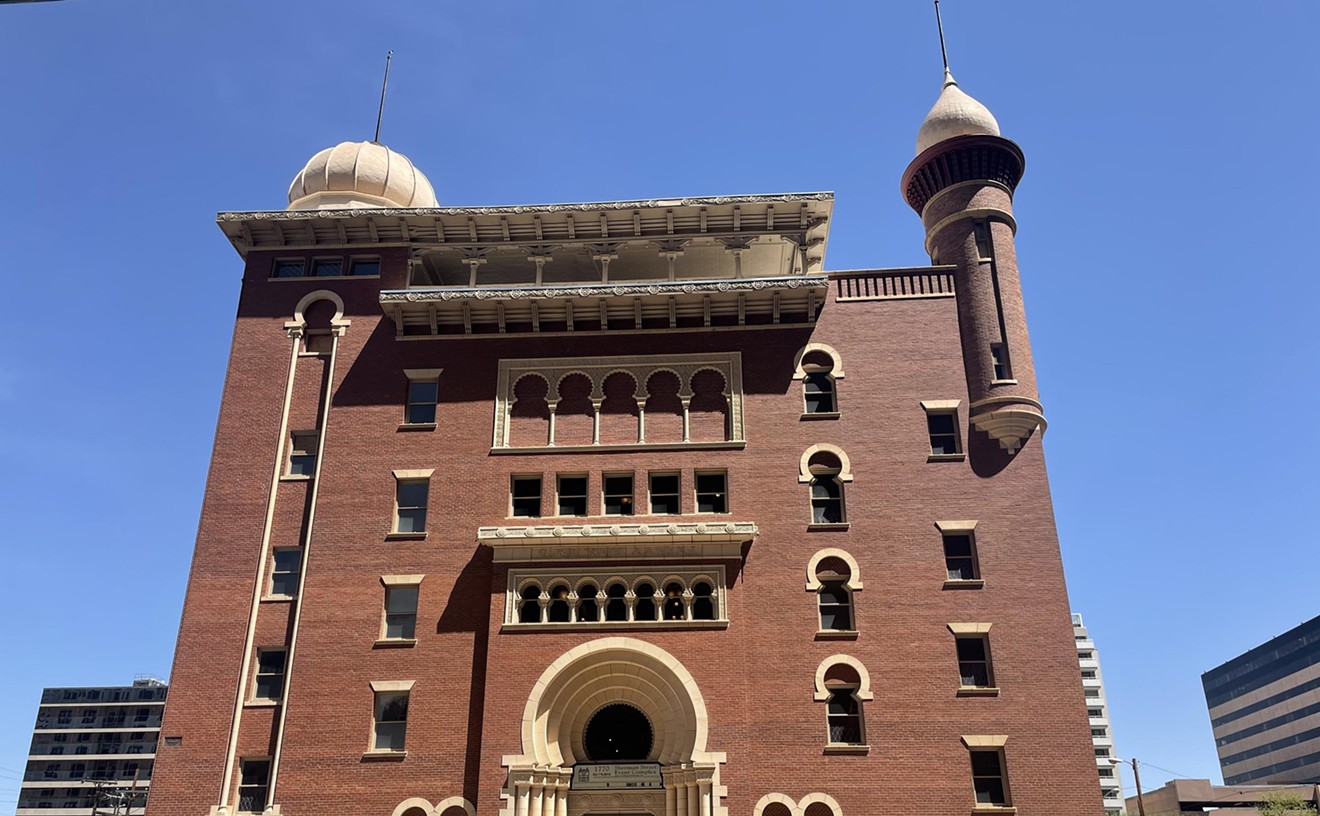In a twenty-page letter dated August 21 and addressed to Stephanie Foote, manager of Denver's Public Works department (and copied to Mayor Wellington Webb), Cypser lays out her case in polite but blunt terms: "It is the position of Go-Go Media, LLC, that this News Rack ordinance and the manner in which it is enforced violates our rights under Amendments 1, 4, 5 and 15 of the U.S. Constitution, as well as Article 2, Sections 10 and 25, of the Colorado Constitution." Later in the document, she makes several demands, including "the immediate suspension" of the ordinance's enforcement, before adding, "If these actions are not taken by September 21, 2002, then Go-Go Media, LLC, intends to file suit in District Court under 42 U.S.C. Sec. 1983 seeking injunctions and damages against the City and County of Denver and appropriate employees of the City and County of Denver."
Giving the city an ultimatum isn't something Cypser's doing lightly. But she decided to take a stand because, in her view, the law has not only hurt Go-Go's bottom line, but it could potentially drive other publications out of business entirely. "The ordinance favors the two largest newspapers in the state [the Denver Post and the Rocky Mountain News]," she says. "And the alternative papers, which tend to have smaller cash flows and publish less frequently, are all being discriminated against."
Evidence supporting this contention can be found in the ordinance, which asserts that "publishers who issue a new edition at least five days a week are more likely to advance significant government interests in cleanliness and good maintenance than publishers who issue a new edition less frequently." Therefore, "it is reasonable to make those publications with the fastest turnover most accessible to the public."
Such a declaration isn't a big surprise, given that the Denver Newspaper Agency, which handles the business operations for the Post and the News, had a great deal of input into the ordinance; other publications weighed in to a lesser degree. But Cypser can't help but be frosted by it, particularly since Go-Go is far more reliant on news racks than are the big Denver dailies. While her magazine is available at assorted retail businesses, she notes that many of those establishments are closed at night, when revelers looking for something to do are most likely to want copies, thereby making news boxes absolutely vital.
A wide range of other publications, from employment and apartment guides to weeklies like this one, are just as dependent on news racks. However, the ordinance, which was unanimously passed by Denver's city council in late October 2001 and has been enforced since this past spring, makes only passing reference to such concerns. More typical are statements such as, "The uncontrolled placement and maintenance of news racks in the public right-of-way presents an inconvenience and danger to the safety and welfare of persons using such right-of-way."
In attempting to address these and many other matters, the council established a system in which publishers are required to buy a $7 permit for each box. The racks themselves must meet detailed requirements, as do the bolts that are used when affixing them to sidewalks. Additionally, no news boxes are allowed on the 16th Street Mall, or within fifty feet of the mall's property lines, with the exception of so-called "news rack corrals" constructed under the auspices of the Denver Newspaper Agency. Elsewhere in the city, racks can't be within two feet of the curb face or pavement edge of any roadway; within three feet of a marked crosswalk; or within five feet of a fire hydrant, fire or police call box, parking meter, traffic-control cabinet, entrance to public transit shelters or telephone enclosures, driveway, public artwork, tree or bicycle rack. (Some bike racks have been placed precisely nine feet apart in order to guarantee that no news boxes can be legally placed between them.) Fortunately, being within five feet of oxygen molecules is still okay.
By their very nature, these policies, and others like them, limit the quantity of news racks in high-traffic areas -- thereby reducing potential readers' access to publications, and vice versa. But there's another way for papers and magazines to lose boxes: The ordinance requires the city to inform publishers when any rack is in violation, and if the problem isn't cured quickly enough, the box will be impounded. Companies can retrieve their racks for the price of a $50 fine plus a $25 re-inspection fee, which isn't much of a bargain in Cypser's opinion because Go-Go's news boxes cost $65 apiece. Racks that aren't retrieved within a prescribed period are destroyed.
Among the most common reasons for impoundment is graffiti; publishers are required to keep their boxes free of such vandalism. Detective Abel Gutierrez of the Denver Police Department's anti-graffiti unit says there are numerous tagging teams at large right now, sporting monikers like SWS ("Society Will Suffer") and DE ("Destroy Everything"), and the city actually pays to clean up most damage they do to buildings. (The exception is windows ruined by "mosh ink," a combination of white shoe polish and acid-based etching cream used by hobbyists, which actually eats into glass. As a result, many downtown business owners are covering their windows with clear Mylar sheets that help protect their property.) When it comes to news boxes, though, the city won't get its hands dirty. No cleaning, just seizing.
Making this situation worse in Cypser's view is what she sees as uneven enforcement of the ordinance. She repeats anecdotal accounts of news boxes owned by smaller publications being grabbed, but besmirched Post or News racks next to them receiving a pass. (Denver Newspaper Agency spokesman Jim Nolan dismisses accusations of favoritism, pointing out that the city has snatched seventeen Agency boxes so far this year.) And in her letter, Cypser tells of an incident involving a Go-Go box that was picked up in June 2002 because it wasn't labeled with the magazine's phone number; apparently a sticker with this information had fallen off. Cypser says Go-Go was never informed about the rack-napping and didn't learn until July 31 that the box had been disposed of four weeks earlier. To add insult to injury, Go-Go had to fork over a dollar to get a copy of the violation notice that should have been mailed to the firm but wasn't.
Rob Duncanson, an engineering supervisor with Public Works, isn't familiar with this situation, but he says that the city is doing its best to be fair and responsible in the way it supervises news racks. "We have to notify the vendors by certified mail, as well as by electronic mail, about any violation," he says. "We try to make sure that they get instant notice." But at the same time, he concedes that the job of policing news boxes is an enormous one, given all that Public Works has on its plate. The department divvies up approximately 20,000 permits per annum in 33 categories, with news racks accounting for a significant chunk of the total; the DNA alone has more than 2,000 boxes in Denver. Yet a single city inspector, Sherri Ivy, was put in charge of educating publishers about the new ordinance and overseeing enforcement.
Understaffing aside, Duncanson feels that "most major publications have been reasonably responsible" when it comes to following the ordinance, "although a lot of the smaller publications have found it hard to deal with the changes."
Some members of this last group are doing better than others. Mike Kirschbaum, publisher of the Denver Daily News, which circulates 8,500 papers five days a week downtown, has had a couple of boxes confiscated, but he doesn't think the ordinance is any more onerous than those passed in Vail and Breckenridge, which he had to comply with prior to moving here. But staying in the city's good graces is expensive. He's had to hire a forty-hour-a-week employee to keep track of his 400 boxes -- and for a publication that only has eight other full-timers, including him, that's a significant expense.
Mike Harmon, president of Jeffco Publishing, which puts out the Sentinel and Transcript newspapers circulated in most metro-area suburbs, isn't worried about costs like these sinking his operation, but he does fear the chilling effect that the proliferation of ordinances like Denver's may have on the flow of information. "No matter how you slice it, they're going to limit access to certain publications," he says. "They're designed to get rid of those supposedly annoying free publications all over the area -- and once you decide who gets into this limited group you've set up, somebody's access is denied."
Maybe so -- but in recent months, several area communities have floated news-rack ordinances anyway, including Boulder; that measure remains in limbo, and Boulder Weekly publisher Stewart Sallo, who was previously up in arms about it ("April Fools," April 11), couldn't be bothered to return a call on the topic. When city councils in Golden and Wheat Ridge debated ordinances of their own, Harmon spoke out against both, but his arguments didn't convince the officials. The ordinances passed by large margins, with enforcement slated to begin soon.
Harmon says he was able to get some changes made in the Wheat Ridge version, which is closely modeled on Denver's blueprint. When an early draft gave first priority to boxes of publications that come out at least five days a week, Harmon reminded the council that this directive would discriminate against Wheat Ridge's hometown weekly, leading to the provision's being dropped. And after it looked as if the new rules would make as many as half his news racks illegal, he negotiated a more reasonable solution -- an option not available to smaller, less influential publications. But he continues to see the ordinance as more restrictive than necessary.
"This absolutely is a First Amendment issue," he says. "And it's more than just a case of free speech. It's going to damage local businesses."
John Desmond, director of downtown environment for the Downtown Denver Partnership, which has pushed for years to get a news-rack ordinance, couldn't disagree more. Although he thinks the Denver law could use some minor tweaks, he otherwise considers it to be a tremendous success, and he says the feedback he's received suggests that he's not alone. "It's been extremely popular with the downtown community, and everyone I've talked to is wholeheartedly in favor of it," he says. This support is important, because the ordinance has a sunset provision that will render it null and void in late 2003 unless it's extended.
In the meantime, Cypser is waiting to hear back from the city about her letter. Assistant City Attorney Kerry Buckey says he'll share Denver's position with her in a letter he intends to send "as a courtesy" prior to Go-Go's September 21 deadline. Cypser hopes whatever response it contains seriously addresses the questions she's raised.
"We'd prefer that the city take a look at our legal arguments and realize that they've got a problem, and take action without going to court," Cypser says. "But if going to court is what we have to do, we're prepared."
Cyber-oops: Most of us have misdirected e-mails -- hit the reply command on a message when we intended to forward it, say, or pasted in a note meant for one pair of eyes that wound up being seen by another. But few gaffes of this sort are as embarrassing as the one recently committed by Denver Post city editor Evan Dreyer.
The victim of Dreyer's faux pas was an assistant city editor, or ACE, at the Post, whose name is being withheld at the employee's request. The ACE decided to leave the paper in order to write a book, and it fell to Dreyer to send out an internal e-mail to inform fellow staffers of the move. But somehow, someway (Dreyer declines to provide specifics), he accidentally attached to an otherwise benign farewell a rather negative performance assessment of the very person whose exit he was announcing.
Sources say Dreyer quickly realized his mistake, and because the Post e-mail system has a feature that allows folks to retrieve communications sent prematurely or inadvertently, he immediately tried to pull back his ACE good-bye. Unluckily for him, several minutes passed before he was able to do so, and during that span, one or more of the designated recipients discovered the bonus attachment and printed it out. News travels fast in the news business, and before long, all but a few of the journalists in town knew about the memo or had a copy of their own.
The document, dated October 24, 2001, faults the ACE for letting a "bad" mistake slip into one story, not filling holes in others and exhibiting a lack of "critical thinking" on a report. But more revealing of the management style at the Post, not to mention the overall atmosphere there, are items grouped under the heading "Suggestions for improvement," most of which sound like excerpts from Dilbert. They include:
•"Coaching reporters. Meet one-on-one with each reporter once every two weeks. Hold regular pod meetings once every couple of weeks."
•"Set goals for reporters. Help each reporter improve in one area. Set goals for story productivity and work with them to generate story ideas, and then stick to the productivity goals and monitor their progress."
•"Maybe spend a night shift just shadowing the copydesk [sic] and getting a better feel for how it all comes together.
•"'Coaching Writers' book." (This is presumably a reference to Coaching Writers: Editors and Reporters Working Together by Roy Peter Clark and Don Fry.)
The final three entries appeared under the "Follow-up" banner:
•"We'll meet every week to develop a more regular format for providing feedback."
•"At next week's meeting, we'll talk more about other steps to take."
•"Overall, we'll review again in 90 days. But this is serious and job is at stake."
Presumably, these difficulties were resolved, because the ACE left by choice almost a year later. For his part, Dreyer, who's ignored most calls or e-mails made to him by Westword over the years, promptly replied to a request for comment this time around. (Feel free to speculate about why.) I regret to inform you that the hearty blend of wheedling, pleading and threatening that he delivered took place off the record.
The one remark Dreyer presented for public consumption is: "It was a horrible mistake, and words can't describe how sorry I am that the document got out."
Let that be a lesson to you, America. Be careful with your e-mail, or what happened to Evan Dreyer -- and, more important, to the departing Post ACE -- could happen to you.
Moving on up: This may seem cruel to say, but veteran Denver Post sportswriter Jim Armstrong is the new Chuck Green. Last week, Post editor Greg Moore informed staffers that Armstrong -- best known for penning "Opening Shots," a regularly scheduled collection of opinions and wisecracks -- has been named the paper's new metro columnist, filling the spot vacated by Green earlier this year. In making this shift, Armstrong, whose new gig starts September 23, is following in the tradition of Post colleague Woody Paige. Of course, Paige subsequently returned to the sports section and now pens only occasional news essays, such as a September 10 report from Ground Zero -- perhaps the least imaginative column idea ever. Good luck topping that, Mr. Armstrong.











